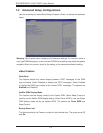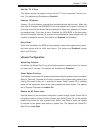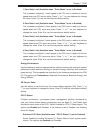
7-12
SUPERSERVER 1018D-73MTF User's Manual
Primary PCIE (PCI-Express Device)
This feature allows the user to specify which graphics card to be used as the
primary graphics card. The options are PCIE1, PCIE2, PCIE3, PCIE4, PCIE5 ,
PCIE6, PCIE7 and Auto.
PCI-E Confi guration
This item displays the information of the (graphics) device installed on a PCI-E
slot.
Riser Card on CPU Slot 6
PEG0 Gen X/PEG1 Gen X/PEG2 Gen X
This feature allows the user to select PCI-E support for the device installed on
SLOT6. The options are Auto, Gen1 (Generation 1), Gen 2 and Gen 3.
Detect Non-Compliance Device
Select Enabled for the AMI BIOS to automatically detect a PCI-E device that is
not compliant with the PCI-E standards. The options are Enabled and Disabled.
Program PCI-E ASPM After OpROM
PCI-E ASPM, the Active State Power Management for PCI-Express slots, is a
power management protocol used to manage power consumption of serial-link
devices installed on PCI-Exp slots during a prolonged off-peak time. If this item
is set to Enabled, PCI-E ASMP will be programmed after OpROM. If this item
is set to Disabled, the PCI-E ASPM will be programmed before OpROM. The
options are Enabled and Disabled.
PEG0-ASPM/PEG1-ASPM/PEG2-ASPM/
Use this feature to set the ASPM (Active State Power Management) level for the
graphics device installed on a PCI-E slot specifi ed by the user. The options are
Disabled, Auto, ASPM L0s, ASPM L1, and, ASPM L0sL1.
PCI-E SLOT 0 ASPM ~ PCI-E SLOT 7 ASPM
This feature confi gures the ASPM (Active State Power Management) settings for
the graphics devices installed on PCI-E SLOT 0 to PCI-E SLOT 7. The options
are Disabled, L0s, L1, L0sL1 and Auto.


















